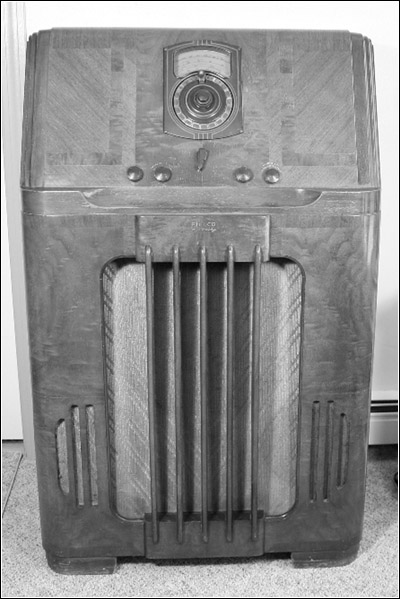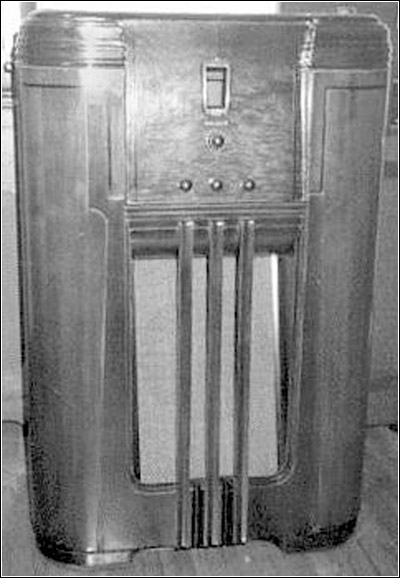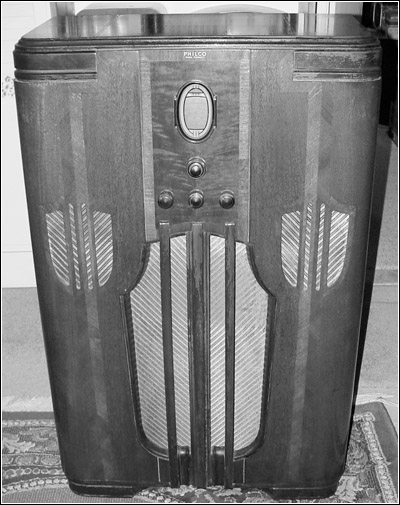Of Old Radios And Related Items--Published Monthly
Philco Milestone Celebrations
Armistice Day 1937BY PAUL TURNEY
Web Edition
The Philco brand loomed large in the first half of the 20th century when every household realized it had to have a radio. Paul Turney traces Philco's amazing production record through its radio milestone celebrations from 1934 to 1947 when it began to shift into TV milestone celebrations. (Editor)
The Philco Radio and Television Corporation commenced the manufacture of radio sets in 1928 and quickly became one of the tube radio era's most prodigious manufacturers. Within a span of just three years, Philco grew to occupy the number one spot in the industry in terms of units sold. By 1935, so impressive were its sales that it would claim, "The American public bought three times as many Philcos as any other make... almost half as many Philcos as all other makes combined." The company continued to ride this tide of success for many years.
From the very outset, Philco realized that in order to sell lots of radios, a flamboyant big-budget marketing policy was necessary, backed by modern, attractive, and reliable products that were readily available for sale at the right price. Whatever steps necessary were taken to ensure that these basic business tenets were maintained. One does not have to delve too deeply into the era's advertising before realizing that Philco succeeded admirably in positioning both its name and products to be omnipresent before the radio buying public.
Whether it was through the production of jumbo-sized "demonstrator" radios, or through extravagant media advertising campaigns, sponsoring of radio shows and celebrities, and seemingly endless announcements for new technological innovations, the company always kept the public abreast of its latest accomplishments and offerings.
A recurrent theme in Philco media advertising was its celebration of key production milestones. This trend was perhaps borrowed from the automobile trade and appears to have started with the announcement of the five millionth set towards the end of 1934. It continued with commemorations for the seventh, tenth, fifteenth, and twentieth million sets over the course of the next 15 years or so. Perhaps the most interesting of these was the celebration of the 10 millionth set, the Model 38-116XX, which happened to coincide with Armistice Day in late 1937.
Figure 1. The Model 38-116XX, the ten millionth Philco set, presented to the Walter Reed Hospital in Washington, D.C., as part of the 1937 Armistice Day celebration.The Model 38-116XX and Armistice Day 1937
Philco's ten millionth set celebration, held during late 1937, followed in the tradition of the earlier ceremonies for which the Philco Models 16X and 116X had taken center stage. The ten millionth set, by design or otherwise, was the Model 38-116XX, shown in Figure 1. This was Philco's next to top-of-the-line set for 1938, a $200 (initially), 15-tube, hi-fi behemoth.
For the occasion, over and above the usual advertising and in-store promotions, Philco gained publicity by presenting the set to the Walter Reed Hospital in Washington, D.C., at a ceremony that was part of the 1937 Armistice Day celebrations in the nation's capital. The 38-116XX was presented to veterans in the hospital by Boake Carter, the famous, if not controversial, Philco Radio news commentator, representing the Philco Radio and Television Corporation.
Secretary of War Harry H. Woodring accepted the radio on behalf of the veterans and servicemen. The interest in this event was such that every seat in the Red Cross House auditorium in the Great Army Medical Center was occupied by soldiers and patients, with yet more space occupied by patients in wheelchairs.
On a silver plate attached to the base of the inclined control panel of the radio was the following inscription:
"This, the ten millionth Philco, is presented to the World War veterans in the Walter Reed Hospital in the hope that it will bring them in closer contact with 'the good things in the air.' November Eleventh, 1937."
During the ceremony, Boake Carter spoke of some of his own wartime exploits twenty years earlier, for which he himself had been hospitalized. He likened listening to the radio while in the hospital to having "a ringside seat as the world rolls by," and added, "Not only in the hospital here, but to other Veterans' hospitals all over the country, replicas of this ten millionth Philco are being presented by the Philco Company at the same [sic] time."
Secretary Woodring concluded the proceedings:
"I know of no greater pleasure than to come here and accept this generous gift on behalf of the Walter Reed hospital. To my mind there is no greater invention than the radio, especially for those who are hospitalized. Philco has given its 10,000,000th radio to the Walter Reed hospital. I recall that when Philco produced its 7,000,000th radio, it gave that instrument to the Warm Springs Foundation, in which our president is so interested. I say now that we express our admiration to Philco for this gift."
In addition to the ten-millionth set and the replicas thereof presented to hospitals, Philco offered a limited number of replicas for sale to the public. Each was sold with a personalized plaque affixed to its inclined control panel bearing an engraving of the purchaser's name preceded by the words, "Exact Replica of the Ten Millionth Philco. Built for .."
Today the 15-tube Philco 38-116XX is much coveted by collectors, with a few appearing for sale yearly at radio shows and on-line venues. Some of the actual ten-millionth replicas complete with engraved plaques, also do occasionally turn up -- for sure, there are known surviving examples. However, one cannot help but wonder what happened to the "exact ten-millionth" set, as presented to the Walter Reed Hospital over seventy years ago. Where was this radio used? Did the resident veterans of a former "World Crisis" use it to keep up with the unfolding events of the next?
We may never know, but what we can say is that this story serves to remind us of the important role that radio once played, and to some extent still does, in various of the nation's institutions that care for the injured and infirm, especially those who fought and paid a heavy price for the freedoms we enjoy today.
Earlier Production Celebrations -- The Five Millionth Philco Radio
In celebration of the production of the five millionth Philco, a 1935 Model 16X, shown in Figure 2, the company and its dealers ran a widespread advertising campaign, offering "greater values, easier terms and more liberal trade-in allowances than ever before." Contests, such as one that ran in stores in western Oklahoma, eastern New Mexico and the Texas Panhandle, gave away Philco prizes to the top 50 entrants of a 100-word letter entitled, "Why I would like to own the five millionth Philco."
Figure 2. The five millionth Philco set, a Model 16X, was promoted by a widespread advertising campaign, including contests and special offers. (Photo courtesy of John Goller)The first prize was the five millionth Philco, a $175 Model 16X. It was won by a Mrs. J.M Hurst, whose letter was read aloud at the opening ceremony of a newly-retrofitted furniture store in Wellington, Texas, where Philco radios were sold.
Another advertising theme was comprised of special offers made on "furniture ensembles," a Philco radio being the centerpiece. One such ensemble, advertised by a furniture store in Valparaiso, Indiana, included a 6-tube Model 45L console, a world globe, a walnut end table, a modernistic bridge lamp complete with parchment shades, a luxurious armchair, and a beautiful wall mirror, all for the price of $59.95. This was the normal price of the radio alone! A rider was added to this deal to the effect that "any Philco model may be had in combination with this ensemble."
This ensemble was rather more generous than most I've seen advertised, but the general intent was no doubt to entice the public into stores. Once there, the hope was that they would buy Philco radios of equal or greater value than the one offered, even if the ensembles had all been sold. Imagine the rush once these deals were announced!
A newspaper report from the Texas Wellington Leader, December 1934, summarizes the Philco advertising planned for this grand occasion: "Philco will celebrate the production of its five millionth radio with a stupendous 11-week continuous advertising campaign in every important medium, including newspapers, magazines and broadcasting. It is estimated that 1,100,089,883 separate Philco advertisements will appear during this campaign. This is approximately ten advertisements for every person in the United States between now and Christmas"
The Seven Millionth Radio
Just over a year after the five millionth event, in early 1936, Philco staged a promotion for its seven millionth set, which was a 1936 Model 116X, a $175 11-tube hi-fi console, shown in Figure 3. Once again, Philco mounted a media advertising blitz, with special promotions, contests and drawings used to attract people into the stores where Philcos were sold.
Figure 3. The seven millionth Philco set, a 1936 Model 116X, produced in the Philadelphia factory and given an official blessing by the mayor.As the seven millionth set completed its trip down the production line in Philco's Philadelphia factory, S. Davis Wilson, the city's mayor, was present at the plant to place his official blessing on the radio. He and several of his staff, accompanied by members of the press, had traveled to the plant to congratulate Philco on its "unprecedented record" and "to offer the city's gratitude for having given steady employment to thousands of Philadelphians and having added more than $37,000,000 to the city's payroll."
On behalf of Philco, the ceremony was attended by James M. Skinner, president, Philadelphia Storage Battery, and Larry E. Gubb, president, Philco Radio & Television Corp. Shortly thereafter, perhaps at yet another ceremony, this exact seven millionth set was presented to the Warm Springs Foundation, renowned for its association with polio survivor President Franklin D. Roosevelt.
Limited numbers of replicas of the seven millionth set were offered for sale to the public, bearing a commemorative medallion stating the set to be an "exact replica of the seven millionth Philco." Has anyone seen or heard of the existence of one of these commemorative sets in recent times? I haven't.
Later Milestones
Philco celebrated the production of its fifteen millionth set in late 1940, three years after the tenth. The big feature at this time was Philco's "Beam-Of-Light" phonograph. "Reproduces Records On A Beam-Of-Light" was the catch phrase.
The twenty millionth Philco radio was produced in late 1947, seven years after the fifteenth, including a lull of three or four years caused by World War II. Philco commissioned Bing Crosby to make a phonograph recording especially for this occasion, containing Blue of the Night, his famous theme song from "Philco Radio Time," and the popular lullaby Home on the Range. Autographed copies were given away with Philco radio and phonograph purchases made during the celebrations.
The instance of the twenty millionth set appears to have been Philco's last publicized celebration of radio production. However, perhaps that was because the company had switched to commemorating television milestones, starting with the one millionth set in 1954! But that's quite another story.
References:
Brainerd Daily Dispatch, Brainard, Minnesota, December 13, 1934, p 16.
Indiana Evening Gazette, Indiana, Pennsylvania, March 3, 1936, p 7.
The Charleston Daily Mail, Charleston, West Virginia, November 21, 1937, p 10.
Vidette-Messenger, Valparaiso, Indiana, November 21, 1934, p 8.
Wellington Leader, Wellington, Texas, December 20, 1934, p 1.
Paul Turney has been collecting vintage radios on and off since he was a teenager. He has been a serious collector since 2001, focusing on sets from the 1930s and early 1940s. You can see more of his collection, and learn more about the sets and events described in this article, at his website:- www.tuberadioland.com
|
[Free Sample] [Books, etc., For Sale] [Subscribe to A.R.C./Renew] [Classified Ads] [Auction Prices] [Event Calendar] [Links] [Home] [Issue Archives] [Book Reviews] [Subscription Information] [A.R.C. FAQ]URL = http://www.antiqueradio.com/Nov08_Turney_Philco.html Copyright © 1996-2008 by John V. Terrey - For personal use only. Last revised: October 30, 2008. For Customer Assistance please contact ARC@antiqueradio.com or call (866) 371-0512 toll free Pages designed/maintained by Wayward Fluffy Publications Antique Radio Classified |


